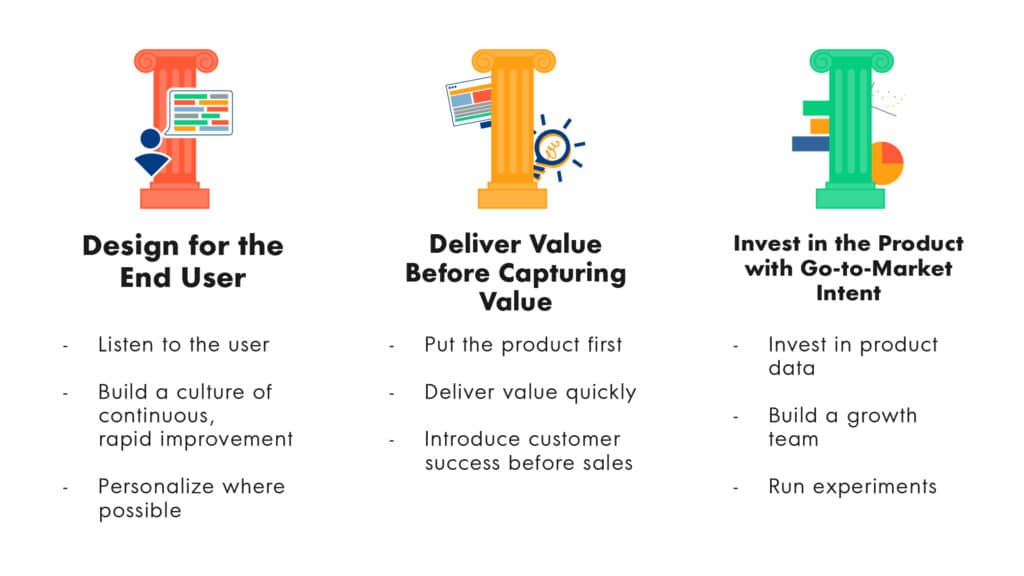An effective product-led growth strategy (PLG) is a mechanism that firms employ to convert active users into paying customers, retain them, and acquire new customers through referrals.However, implementing a PLG approach effectively takes more than simply following a formula.
By acknowledging that articulating the value of your product is essential, you can better grasp how PLG works.
A closer look at what product-led growth is, how it originated from current businesstrends, and how shifting customer expectations are influencing it will be discussed in this session.In the end, we'll look at how you might apply this new way of thinking to your own company.

Exploring Product Led Growth
What Is Product-Led Growth?
The concept of product-driven growth has a weird past.
Although it has lately been formalized and marketed by a single organization (OpenView Venture Partners), the basic foundations of the idea have been around for decades.
Product-led growth is based on the idea that if a product offers actual value to customers, they will begin to incorporate it into their daily routines.Peers and associates will feel pressured to embrace the same product because they want systems that are compatible with their coworkers, or because a buddy has recommended it as an excellent tool.
In this level of abstraction, product-led growth appears to apply to practically any successful product, but it does not.
When compared to more "conventional" development methods, product-led growth strategies have one major advantage: they focus on providing actual value to customers in a way that motivates them to refer a product to others in their network.Rather than relying on word-of-mouth to spread the word about your product, you should make it easy for others to do the same.
In recent years, there have been numerous examples of this.
Cloud-based office software suites like Sync and Google Drive, which emphasize their collaboration features to entice users to share the platform with their colleagues, have been the most successful, in our opinion.
Product-led growth can be used in any situation where customers need to exchange information.
Benefits Of Product-Led Growth
Faster and more efficient growth are at the heart of product-led growth.
Every step of the customer's journey demonstrates this.
Lower Acquisition Costs With Product-Led Growth
Slack, Dropbox, and Calendly are some of the most well-known examples of product-led growth.Do you remember how you first learned about this company?
What sparked your interest in them?
These items probably weren't adopted by your firm or you because of an advertisement or a whitepaper.You may not have ever heard of them before you started using them.
Growth driven by products assumes that a good product will find its way into the market and expand on its own.
Dropbox or Calendly may have been used by someone you know.
Files were sent to you, or an invitation was issued to you.
You were the one who did the opening.You've been transformed into a user overnight.To acquire you, exactly, how much did product-driven growth company X pay?Yes, you read that correctly - a solitary penny.
Increase Retention And Upsells With Product-Led Growth
In the alternative, product-driven growth can be used to reduce churn.
A product-led growth strategy in sales helps salespeople find better leads because they know who is using the product and who is getting value out of it, as we previously discussed.
It is also important to know who isn't using the product and what benefits they're losing out on.In a product-led growth model, CS teams will have access to user engagement data because the focus is on how users interact with the product.
So businesses can better target their upsell and churn reduction efforts by getting a clear picture of who is and isn't interested.
Give Users A Better Experience With Product-Led Growth
It's a matter of stating the obvious:The user's experience increases as a result of product-driven growth.
It's easier for consumers to sign up and pay, and people can pay just if they think it's worth it.There's no guarantee of return.There's only value for the end user in this situation.
Your product is the only thing that matters when it's the only thing that matters to you.Everything you do is based on user feedback, and you're doing everything you can to provide the best possible experience for them first and foremost.
The 3 Pillars Of Product-Led Growth
Pillar 1: Design For The End User
Users have taken the reins and are now in charge.The ultimate customers of a product or service are people, and they don't think in terms of numbers.People, on the other hand, are eager to find a solution to their current difficulty.In the words of Calendly CEO and Founder, Tope Awotona, "Designing for end users is really understanding what they do—and it's also really understanding who you serve.That is to say, designing for end users involves putting actual people's needs first, listening to their concerns, and committing to making constant adjustments to your product in order to better address those problems.
Pillar 2: Deliver Value Before Capturing Value
True love requires compromise.You must first deliver value to your users before expecting value in return.That's why product-driven businesses target quick value (TTV).This idea is commonly implemented as a self-serve free trial, freemium model, or open-source approach where consumers can access some or all of the product before paying.But a delayed paywall isn't always valuable.
There must be a step between a user signing up for your product and entering their payment card information.Specifically, users must see your product's worth.
To do this, you must either solve the user's problem quickly or bring them to the vital “aha” moment where the proverbial light bulb goes out and they realize how your product will improve their daily lives.
This includes not only adding features and functions that exemplify the value, but also removing obstacles that distract from it.
Pillar 3: Invest In The Product With Go-To-Market Intent
For a first customer, the expenses of developing software are often higher than those of providing professional services.
After that, delivering the same value to a second consumer is almost free.That can make the initial investment very profitable.
The same goes for launching a product.A software distribution model has a far lower marginal cost than a professional service model.

